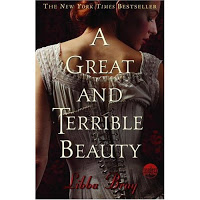The following books all are set at a boarding school and follow a group of young people, but are not necessarily about “secret societies” nor is the central mystery always a murder (but sometimes it is). Two are YA books. All are books I enjoyed reading. Without further ado….
A Great and Terrible Beauty by Libba Bray (YA) (First in a trilogy)

This one is set in 1895 and has a supernatural element to it. There is no secret society but rather a group of young women dabbling with power they do not understand. My inclusion of this book in my made up sub-genre is questionable, but hey I am making the rules so I can also break them.
As far as I am concerned, this is a middle grade book, not YA…it feels younger than YA to me. Given the target age range, it is an easy, fast read, and I think a good book for that generation. I wasn’t bored by it, despite being long past the teenage years, but I couldn’t relate directly to some of the angst the way a teenage or preteen girl would. What I DID like was the historical element of this novel. The basic premise is 4 teenage girls at a boarding school in 1895 England, where they are supposed to be learning how to be ladies, and eventually, wives. Instead they get caught up in a supernatural other world which changes them in ways both good and bad.
What I liked the most was how the author focuses on how desperate and trapped these girls feel due to their circumstances in that era. Over and over again Bray reminds us how few choices women had in that time, and that often none of the choices were pleasant ones.
In the supernatural world the girls are free and can do what they wish….who can blame them for being sucked in and refusing to examine the consequences? There are some parts of the story that do not hang together quite as well and the character development is thin, but this is an enjoyable book. Just bear in mind the age range it is aimed at if you read it. (I completed the trilogy and felt the first book was the best).
The Raven Boys by Maggie Stiefvater (YA, first in a series of 4)

This is a strange series with a lot of ideas, firmly in the supernatural category. It’s definitely a unique story line and there were many surprises. The best part of all the books are the characters – in this case, our crew are all people we love and root for. The boys are all students at an elite prep school, and a local girl, Blue, becomes part of their clique in the first book. They definitely have that overly intelligent, precocious vibe common to the sub-genre, and they are all obsessed with studying ley lines and the supernatural, just as The Secret History students were into Classic mythology. What I liked is that in The Raven Boys, they are all wonderful characters – even when they are behaving badly I loved them.
The problem with the series is that there are too many ideas. The books become increasingly complex and convoluted, and the final book doesn’t wrap things up nicely at all. It felt very much that the author was overly ambitious. However – she’s an excellent writer of prose and character studies. I’d still recommend the first book as very enjoyable, and I also note that many, many readers on Goodreads strongly disagree with me and loved all four books. I may be in the minority in my views and I definitely feel there is plenty here that is worthwhile, so I would still recommend.
She Was the Quiet One by Michele Campbell (Not YA)

I’ve read several books by this author, and this one is my favorite. It is a fast-read whodunit that was such great fun. Set at an expensive boarding school in the east, the story revolves around a murder of one of a set of twins…but which one? And who killed the twin? The story skillfully moves back and forth between events leading to the murder and interviews by the police. Both twins have POVs as does a teacher and head of the dorm where the girls live. This book has drama, romance, seduction, scandal, and characters that you root for even when they frustrate you. Everything just works, and the ending was a fun surprise.
There is no secret society and “elite clique” is also a stretch – the group of kids in question is probably better described as a “rough crowd.” However, it’s set at an elite boarding school and has a murder, so I am keeping it in my sub-genre.
Happy reading!

